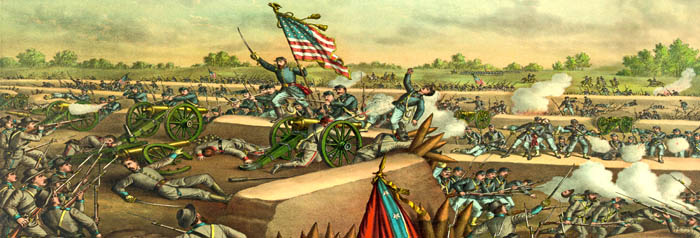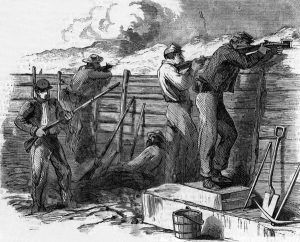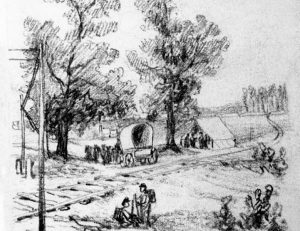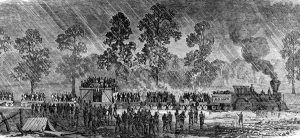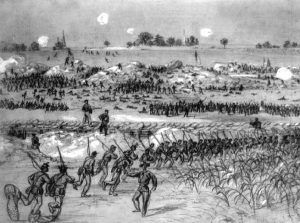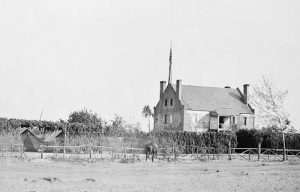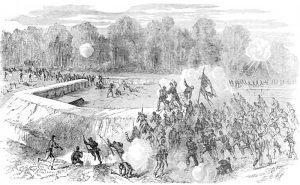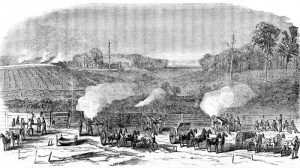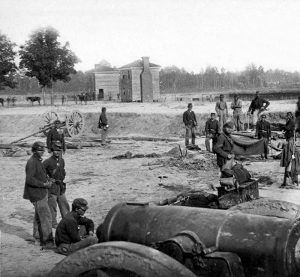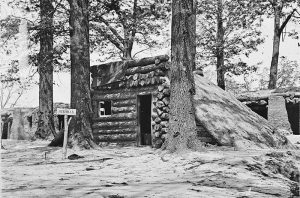The Richmond-Petersburg Campaign, also known as the Siege of Petersburg was a series of battles around Petersburg, Virginia, fought from June 9, 1864, to March 25, 1865.
Petersburg, Virginia, was a vital rail center that brought critical supplies to nearby Richmond, the capital of The Confederacy. As such, Union General Ulysses S. Grant knew that if Petersburg fell, Richmond would be right behind it. knew that if Petersburg fell, Richmond would be right behind it.
Not a classic military siege, in which a city is surrounded, and all supply lines are cut off, the battles in southern Virginia were not strictly limited to actions against Petersburg. In June 1864, Grant marched his army around the Army of Northern Virginia, crossed the James River, and advanced his forces to Petersburg. In the meantime, Confederate General Robert E. Lee raced to reinforce the defenses at Petersburg.
The campaign began by the Union assaulting Petersburg unsuccessfully. The Union then constructed trench lines that eventually extended over 30 miles from the eastern outskirts of Richmond, Virginia, to around the eastern and southern outskirts of Petersburg. The next nine months saw one of the most protracted uses of trench warfare during the Civil War.
By late March 1865, with Confederate supplies dwindling and Union pressure mounting, Lee was forced to retreat. Abandoning both Petersburg and Richmond, this soon led to his surrender at Appomattox Court House on April 9, 1865.
During these many months, as many as 185,000 troops were involved on both sides. When it was over, the Union suffered an estimated 42,000 casualties. The Confederate had about 28,000 casualties as well as about 25,000 desertions.
Petersburg I (June 9, 1864) – Also called the Battle of Old Men and Young Boy, this engagement took place in the City of Petersburg, Virginia. On June 9th, Union Major General Benjamin Butler dispatched about 4,500 cavalry and infantrymen against the 2,500 Confederate defenders of Petersburg. While Butler’s infantry demonstrated against the outer line of entrenchments east of Petersburg, Brigadier General August Kautz’s cavalry division attempted to enter the city from the south via the Jerusalem Plank Road but was repulsed by Home Guards. Afterward, Butler withdrew. This was called the “battle of old men and young boys” by local residents. On June 14-17, the Army of the Potomac crossed the James River and began moving towards Petersburg to support and renew Butler’s assaults. The Confederate victory resulted in about 40 Union casualties and 80 Confederate.
Petersburg II (June 15-18, 1864) – This large three-day engagement is also known as the Assault on Petersburg. Marching from Cold Harbor, Major General George Meade’s Army of the Potomac crossed the James River on transports and a 2,200-foot long pontoon bridge at Windmill Point. Union Major General Benjamin Butler’s leading elements, including the XVIII Corps and Brigadier General August Kautz’s cavalry, crossed the Appomattox River at Broadway Landing and attacked the Petersburg defenses on June 15th. The 5,400 defenders of Petersburg under the command of Confederate General P.G.T. Beauregard were driven from their first line of entrenchments back to Harrison Creek. After dark, the XVIII Corps was relieved by the II Corps. On June 16th, the II Corps captured another section of the Confederate line, and on the 17th, the IX Corps gained more ground. General Beauregard stripped the Howlett Line (Bermuda Hundred) to defend the city, and General Robert E. Lee rushed reinforcements to Petersburg from the Army of Northern Virginia. The II, XI, and V Corps from right to left attacked on June 18th but were repulsed with heavy casualties. By now, the Confederate works were heavily manned, and the greatest opportunity to capture Petersburg without a siege was lost. Union General James St. Clair Morton, the IX Corps chief engineer, was killed on June 17th. The Confederate victory resulted in an estimated 8,150 Union casualties and 3,236 Confederate.
Jerusalem Plank Road (June 21-24, 1864) – Also called the First Battle of Weldon Railroad, this four-day engagement took place in Dinwiddie County and Petersburg. On June 21st, the Union II Corps, supported by the VI Corps, attempted to cut the Weldon Railroad, one of the major supply lines into Petersburg. The movement was preceded by Major General Cadmus Wilcox’s cavalry division, which began destroying tracks. On June 22nd, troops from Lieutenant General Gen. A.P. Hill’s corps led by Brigadier General William Mahone counterattacked, forcing the II Corps away from the railroad to positions on the Jerusalem Plank Road. Although the Federals were driven from their advanced positions, they could extend their siege lines farther to the west. The inconclusive battle resulted in an estimated 2,962 Union casualties and 572 Confederate.
Staunton River Bridge (June 25, 1864) – Also called the Battle of Blacks and Whites or Old Men and Young Boys, this engagement occurred in Halifax County and Charlotte, Virginia. On June 22nd, Brigadier Generals James Wilson and August Kautz’s cavalry divisions were dispatched from the Petersburg lines to disrupt Confederate rail communications. Riding via Dinwiddie Court House, the raiders cut the South Side Railroad near Ford’s Station that evening, destroying tracks, railroad buildings, and two supply trains. On June 23rd, General Wilson proceeded to the Richmond & Danville Railroad at Burke Station, where he encountered Confederate General William H.F. Lee’s cavalry between Nottoway Court House and Blacks and Whites (modern-day Blackstone). Wilson followed Kautz along the South Side Railroad, destroying about 30 miles of track as he advanced. On June 24th, while Kautz remained to skirmish around Burkeville, Wilson crossed over to Meherrin Station on the Richmond & Danville and began destroying the track. On June 25th, Wilson and Kautz continued tearing up track south to the Staunton River Bridge, where they were delayed by Home Guards, who prevented the bridge’s destruction. Lee’s cavalry division closed on the Federals from the northeast, forcing them to abandon their attempts to capture and destroy the bridge. By this time, the raiders were nearly 100 miles from Union lines. The Confederate victory resulted in an estimated about 116 Union casualties and 34 Confederate.
Sappony Church (June 28, 1864) – Also called the Battle of Stony Creek Depot, this raid took place in Sussex County. After the Battle of Staunton River Bridge, Confederate Major General William H.F. “Rooney” Lee’s cavalry division pursued Brigadier Generals James Wilson’s and August Kautz’s raiders who failed to destroy the Staunton River Bridge on June 25th. Wilson and Kautz headed east and, on June 28th, crossed the Nottoway River at the Double Bridges and headed north to Stony Creek Depot on the Weldon Railroad. Here, they were attacked by Major General Wade Hampton’s cavalry division. Later in the day, General William H.F. Lee’s Division arrived to join forces with Hampton, and the Federals were heavily pressured. During the night, Wilson and Kautz disengaged and pressed north on the Halifax Road for Reams Station’s supposed security, abandoning many fleeing slaves who had sought security with the Federal raiders. The Confederate victory resulted in estimated total casualties of 1,817.
Ream’s Station I (June 29, 1864) – Early in the morning of June 29th, Brigadier General August Kautz’s division reached Ream’s Station on the Weldon Railroad in Dinwiddie County, which was thought to be held by Union infantry. Instead, Kautz found the road barred by Major General William Mahone’s Confederate infantry division. Union Major General James Wilson’s division, fighting against elements of General William H.F. “Rooney” Lee’s cavalry, joined Kautz’s near Ream’s Station, where they were virtually surrounded. General Mahone’s infantry assaulted their front about noon while General Fitzhugh Lee’s cavalry division threatened the Union left flank. The raiders burned their wagons and abandoned their artillery. Separated by the Confederate attacks, Wilson and his men cut their way through and fled south on the Stage Road to cross Nottoway River, while Kautz went cross-country, reaching Federal lines at Petersburg about dark. Wilson continued east to the Blackwater River before turning north, eventually reaching Union lines at Light House Point on July 2nd. The Wilson-Kautz raid tore up more than 60 miles of track, temporarily disrupting rail traffic into Petersburg, but at a great cost in men and mounts. The Confederate victory resulted in estimated total casualties of 600.
Deep Bottom I (July 27-29, 1864) – Occurring in Henrico County, this three-day engagement is also called the Battle of Darbytown, Strawberry Plains, New Market Road, and Gravel Hill. During the night of July 26-27, the Union II Corps and two divisions of General Philip Sheridan’s cavalry under Major General Winfield Scott Hancock’s command crossed to the north side of James River to threaten Richmond. This demonstration diverted Confederate forces from the impending attack at Petersburg on July 30th. Union efforts to turn the Confederate position at New Market Heights and Fussell’s Mill were abandoned when the Confederates strongly reinforced their lines and counterattacked. During the night of July 29th, the Federals re-crossed the river leaving a garrison as heretofore to hold the bridgehead at Deep Bottom. The Confederate victory resulted in an estimated 1,000 total casualties.
Crater (July 30, 1864) – Also called the Battle of the Mine, this engagement occurred in Petersburg. After weeks of preparation, on July 30th, the Federals exploded a mine in Burnside’s IX Corps sector beneath Pegram’s Salient, blowing a gap in the Confederate defenses of Petersburg. From this propitious beginning, everything deteriorated rapidly for the Union attackers. Unit after unit charged into and around the crater, where soldiers milled in confusion. The Confederates quickly recovered and launched several counterattacks led by Major General William Mahone. The break was sealed off, and the Federals were repulsed with severe casualties. Brigadier General Edward Ferrero’s division of black soldiers was badly mauled. This may have been Lieutenant General Ulysses S. Grant’s best chance to end the Siege of Petersburg. Instead, the soldiers settled in for another eight months of trench warfare. Major General Ambrose E. Burnside was relieved of command for his role in the debacle. The Confederate victory resulted in total estimated casualties of 5,300.
Deep Bottom II (August 13-20, 1864) – This week-long engagement occurring in Henrico County is also known as the Battle of New Market Road, Fussell’s Mill, Bailey’s Creek, Charles City Road, and White’s Tavern. During the night of August 13-14, the Union II Corps, X Corps, and Brigadier General David Gregg’s cavalry division, all under the command of Major General Winfield Scott Hancock, crossed the James River at Deep Bottom to threaten Richmond, coordinating with a movement against the Weldon Railroad at Petersburg. On August 14th, the X Corps closed on New Market Heights while the II Corps extended the Federal line to the right along Bailey’s Creek. During the night, the X Corps was moved to the far right flank of the Union line near Fussell’s Mill. On August 16th, Union assaults near Fussell’s Mill were initially successful, but, Confederate counterattacks drove the Federals out of a line of captured works. Heavy fighting continued throughout the remainder of the day. Confederate General John Chambliss was killed during cavalry fighting on Charles City Road. After continual skirmishing, the Federals returned to the James River’s south side on the 20th, maintaining their bridgehead at Deep Bottom. The Confederate victory resulted in total estimated casualties of 4,600 men.
Globe Tavern (August 18-21, 1864) – Taking place in Dinwiddie County, this engagement is also known as the Second Battle of Weldon Railroad, Yellow Tavern, Yellow House, and Blick’s Station. While Union Major General Winfield Scott Hancock’s command demonstrated north of the James River at Deep Bottom, the Union V Corps and elements of the IX and II Corps under Major General G.K. Warren’s command were withdrawn from the Petersburg entrenchments to operate against the Weldon Railroad. At dawn on August 18th, Warren advanced, driving back Confederate pickets until reaching the railroad at Globe Tavern. In the afternoon, Confederate Major General Henry Heth’s division attacked, driving Brigadier General Romeyn B. Ayres’s division back toward the tavern. Both sides entrenched during the night. On August 19th, Confederate Major General William Mahone, whose division had been hastily returned from north of James River, attacked with five infantry brigades, rolling up Union General Samuel Crawford’s right flank’s division. Heavily reinforced, Union General G.K. Warren counterattacked and, by nightfall, had retaken most of the ground lost during the afternoon’s fighting. On the 20th, the Federals laid out and entrenched a strong defensive line covering the Blick House and Globe Tavern and extending east to connect with the main Federal lines at Jerusalem Plank Road. On August 21st, Confederate General A.P Hill probed the new Federal line for weaknesses but could not penetrate the Union defenses. With the fighting at Globe Tavern, Lieutenant General Ulysses S. Grant succeeded in extending his siege lines to the west and cutting Petersburg’s primary rail connection with Wilmington, North Carolina. The Confederates were now forced to off-load rail cars at Stony Creek Station for a 30-mile wagon haul up Boydton Plank Road to reach Petersburg. Confederate General John C.C. Sanders was killed on August 21st. The Union victory resulted in estimated casualties of 4,279 Union and 1,600 Confederate.
Ream’s Station II (August 25, 1864) – The battles continued in Dinwiddie County when, on August 24, Union II Corps moved south along the Weldon Railroad, tearing up the track, preceded by Brigadier General David Gregg’s cavalry division. On August 25th, Confederate Major General Henry Heth attacked and overran the faulty Union position at Ream’s Station, capturing 9 guns, 12 colors, and many prisoners. The old II Corps was shattered. Major General Winfield Scott Hancock withdrew to the main Union line near the Jerusalem Plank Road, bemoaning his troops’ declining combat effectiveness. The Confederate victory resulted in total estimated casualties of 3,492.
Chaffin’s Farm and New Market Heights (September 29-30, 1864) – This two-day engagement to place at New Market Heights, Forts Harrison, Johnson, and Gilmer; and Laurel Hill in Henrico County. During the night of September 28-29, Union Major General Benjamin Butler’s Army of the James crossed James River to assault the Richmond defenses north of the river. The columns attacked at dawn. After initial Union successes at New Market Heights and Fort Harrison, the Confederates rallied and contained the breakthrough. General Robert E. Lee reinforced his lines north of the James River, and, on September 30th, he counterattacked unsuccessfully. The Federals entrenched, and the Confederates erected a new line of works cutting off the captured forts. Union General Hiram Burnham was killed. As Lieutenant General Ulysses S. Grant anticipated, General Robert E. Lee shifted troops to meet the threat against Richmond, weakening his lines at Petersburg. The Union victory resulted in total estimated casualties of 4,430 men.
Peebles’ Farm (September 30-October 2, 1864) – With skirmishing occurring at several sites in Dinwiddie County, this three-day engagement is also known as the Battles of Poplar Springs Church, Wyatt’s Farm, Chappell’s House, Pegram’s Farm, Vaughan Road, and Harmon Road. In combination with Union Major General Benjamin Butler’s offensive north of the James River, Lieutenant General Ulysses S. Grant extended his left flank to cut Confederate lines of communication southwest of Petersburg. Two divisions of the IX Corps under Major General John G. Parke, two divisions of the V Corps under Major General G.K. Warren, and Brigadier General David M. Gregg’s cavalry division were assigned to the operation. On September 30th, the Federals marched via Poplar Spring Church to reach Squirrel Level and Vaughan Roads. The initial Federal attack overran Fort Archer, flanking the Confederates out of their Squirrel Level Road line. In the late afternoon, Confederate reinforcements arrived, slowing the Federal advance. On October 1st, the Federals repulsed a Confederate counterattack directed by Lieutenant General A.P. Hill. Reinforced by Major General Gershom Mott’s division, the Federals resumed their advance on October 2nd and captured Fort MacRae which was lightly defended, and extended their left flank to the vicinity of Peebles’ and Pegram’s Farms. With these limited successes, Major General George G. Meade suspended the offensive. A new line was entrenched from the Federal works on Weldon Railroad to Pegram’s Farm. The Union victory resulted in total estimated casualties of 3,800 men.
Darbytown and New Market Roads (October 7, 1864) – Also called the Battle of Johnson’s Farm and the Battle of Fourmile Creek, this engagement took place in Henrico County. Responding to Fort Harrison’s loss and the increasing Federal threat against Richmond, General Robert E. Lee directed an offensive against the Union far right flank on October 7th. After routing the Federal cavalry from their position covering Darbytown Road, Major Generals Robert Hoke’s and Charles W. Field’s divisions assaulted the main Union defensive line along New Market Road and were repulsed. Confederate General John Gregg of the Texas brigade was killed. The Federals were not dislodged, and General Robert E. Lee withdrew into the Richmond defenses. The Union victory resulted in an estimated 458 Union casualties and 700 Confederate.
Darbytown Road (October 13, 1864) – Skirmishing continued in Henrico County in this engagement also known as the Battle of Alms House. On October 13th, Union forces advanced to find and feel the new Confederate defensive line in front of Richmond. While mostly a battle of skirmishers, a Federal brigade assaulted fortifications north of Darbytown Road and was repulsed with heavy casualties. The Federals retired to their entrenched lines along New Market Road. The Confederate victory resulted in an estimated 437 Union casualties and 513 Confederate.
Fair Oaks and Darbytown Road (October 27-28, 1864) – Also taking place in Henrico County, this engagement is also called the Second Battle of Fair Oaks. In combination with movements against the Boydton Plank Road at Petersburg, Union Major General Benjamin Butler attacked the Richmond defenses along Darbytown Road with the X Corps. The XVIII Corps marched north to Fair Oaks, where it was soundly repulsed by Major General Charles W. Field’s Confederate division. Confederate forces counterattacked, taking some 600 prisoners. The Richmond defenses remained intact. Of Lieutenant General Ulysses S. Grant offensives north of the James River, this was repulsed most easily. The Confederate victory resulted in estimated casualties of 1683 Union and 100 Confederate.
Boydton Plank Road (October 27-28, 1864) – Also known as the Battles of Hatcher’s Run and Burgess’ Mill, this two-day engagement occurred in Dinwiddie County. Directed by Major General Winfield Scott Hancock, divisions from Union corps II, V, and IX Brigadier General David Gregg’s cavalry division, numbering more than 30,000 men, withdrew from the Petersburg lines and marched west to operate against the Boydton Plank Road and South Side Railroad.
The initial Union advance on October 27th gained the Boydton Plank Road, a major campaign objective. That afternoon, a counterattack near Burgess’ Mill spearheaded by Major General Henry Heth’s division and Major General Wade Hampton’s cavalry isolated the II Corps and forced a retreat. The Confederates retained control of the Boydton Plank Road for the rest of the winter. The Confederate victory resulted in estimated casualties of 1,758 Union and 1,300 Confederate.
Hatcher’s Run (February 5-7, 1865) – Fighting continued in Dinwiddie County during this three-day engagement also known as the Battles of Dabney’s Mill, Rowanty Creek, Armstrong’s Mill, and Vaughan Road. On February 5th, Brigadier General David Gregg’s cavalry division rode out to the Boydton Plank Road via Ream’s Station and the Dinwiddie Court House to intercept Confederate supply trains. Union Major General G.K. Warren with the V Corps crossed Hatcher’s Run and took up a blocking position on the Vaughan Road to prevent interference with Gregg’s operations. Two divisions of the II Corps under Major General A.A. Humphreys shifted west to near Armstrong’s Mill to cover Warren’s right flank. Late in the day, Confederate Major General John B. Gordon attempted to turn Humphrey’s right flank near the mill but was repulsed. During the night, the Federals were reinforced by two divisions. On February 6th, Gregg returned to Gravelly Run on the Vaughan Road from his unsuccessful raid and was attacked by Brigadier General John Pegram’s Confederate division elements. Warren pushed forward a reconnaissance in Dabney’s Mill’s vicinity and was attacked by Pegram’s and Major General William Mahone’s divisions. General Pegram was killed in action. Although the Union advance was stopped, the Federals extended their siege works to the Vaughan Road crossing of Hatcher’s Run. The Union victory resulted in estimated Union casualties of 1539 and 1161 Confederate.
Fort Stedman (March 25, 1865) – In a last-gasp offensive, General Robert E. Lee amassed nearly half of his army in an attempt to break through Lieutenant General Ulysses S. Grant’s Petersburg defenses and threaten his supply depot at City Point. Directed by Major General John B. Gordon, the pre-dawn assault on March 25th overpowered the garrisons of Fort Stedman and Batteries X, XI, and XII. The Confederates were brought under a killing crossfire, and counter-attacks led by Union Major Generals John G. Parke and Brigadier General John F. Hartranft contained the breakthrough, cut off, and captured more than 1,900 of the attackers. During the day, elements of the II and VI Corps assaulted and captured the entrenched picket lines in their respective fronts, which had been weakened for the assault on Fort Stedman. This was a devastating blow for General Lee’s army, setting up the Confederate defeat at Five Forks on April 1st and the fall of Petersburg on April 2-3. The Union victory resulted in estimated casualties of 950 Union and 2,900 Confederate.
Compiled and edited by Kathy Weiser-Alexander/Legends of America, updated May 2021.
Also See:
Sources:
Battlefields.org
History.com
National Park Service Battle Descriptions (no longer available online)
National Park Service Civil War
Wikipedia

